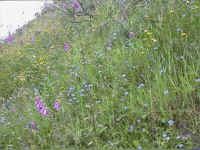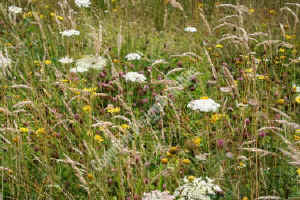| If purchasing this
seed mix, print this page and keep it as your reference.
Native Origin Irish Wildflower
Seed Mixture: Range: Meadow Mixtures (Code
MM)
Product Name: MM07 Wild
Flora for Dry Acid Soil (often shallow over stone)
Supplied
without grass, Grass seed can be added
Product Code: MM07
Number of Species:
34
+
Description:
Meadow Mixture - MM07 - Dry Acid Soil is designed for the (low
rainfall) dry East Coast of Ireland and parts of the North East and
South-East Coast where there is less rain fall and where the soil is usually without
Lime (ph neutral to acid) and stony.
This is a seed mixture that can be sown with grass seed. Use only 1.5 grams per metre.
This mixture may seem limited as some
of the most popular species such as the annual Poppy and Field
Scabious are not included, However, if you can establish this meadow, it
will be very colourful.
MM07 is ideal for sites with a slope, usually these soils contain broken
flat stones mixed throughout and often lying just below the surface of the
soil. The yellow shrub Gorse (furze) tends to grow well in such areas, as
does Bracken, Both weeds must be controlled until the meadow establishes.
Species
List:
Bluebell, Birdsfoot Trefoil, Centaury, Eyebright, Foxglove, Hemp Agrimony, Kidney Vetch, Lady's Bedstraw, Lesser
Knapweed, Mullein, Meadow Buttercup, Ox-eye Daisy, Red Campion, Red Clover, Ribwort Plantain, Rough
Hawksbit, Sheep's
Bit Scabious, Selfheal, Sorrel, St. Johnswort, Wild Carrot, Yarrow, Yellow Rattle,
White Stonecrop, Bell Heather, Sheep's Sorrell,
Wood Sage, White Bedstraw. Bush Vetch, Broadleaf Plantain,,
Annuls include: Corn
Marigold, Corncockle, Scentless Mayweed, Red Bartsia.
Cowslip
in small quantities has been added, but would not be typical found on Acid dry
earth.
MMO7 requires cutting every year and most of all 'raking up' or 'gap
creating' to keep the weeds from invading it.
Often such site were once suited to fire management instead of cutting.
However managing a meadow by fire is dangerous, especially as more than
the meadow may burn, therefore not recommended.
Instead if the site allows,
after cutting and when the bulk of material is removed this mixture can be
'burnt over' with a flame gun in suitable patches as many of the species
respond well to starting afresh on new clean ground. Where
there are wet pockets on site sow a more suitable mixture to add further
interest to the meadow.
The biennial sky blue Sheep's Bit and a mixture of Heathers are often included
although difficult to grow, if the conditions are suited to these species,
(after burn) they make a lovely addition to this mixture.
MM07
will easy on flat or gently sloping ground.

Steep
Sloping Ground: MM07 is a difficult meadow to establish and
maintain on a steep sloping site, as it often cannot be cut. Customers have often
contacted me, after using heavy machinery to clear Bracken, Gorse or shrubs from
such steep sloping sites. As they wish to create a low cut no maintenance meadow.
Steep
slopes are difficult to maintain. I often advise that trees or shrub with
a suitable woodland wildflower mixture may be a better choice 9an accept
some bracken, as some
sites are too steep to safely cut and will if uncut revert to the original
flora that grew on the site in the first instance. Good design and
management is the secret to success when using MM07 on steep sites.
Preparing a steep sloping site is also a difficult task, seek advice.
Mixture Specifications:
Origin: Native Irish Origin, Wildflower Seed
Mixture.
Moisture Level: For dry or very dry well drained soil.
pH range: Best between 5. - 6.5
Aspect: Sunny
Life Cycle: Annual / Biennial /
Perennial.
Height Range: <30cm - > 100cm, where foxglove thrive it
will be taller
Flowering Period: Main flowering May to July, occasionally
through August.
Fertility Range: Will
grow on any infertile soil.
Wintergreen: Moderate
Total number of seeds per gram: 1980
This
photograph is one day in the life of an ever changing meadow.

Product
Warning: DBN
recommends that this mixture is not for human or animal consumption.
Sowing Specification:
Soil Preparation:
'Stone pick' the site. Try not to cultivate
the soil in such a way that it brings up the hidden layers of stone. It
would be better to kill or the surface vegetation and not plough or
rotavate, Shallow cultivate instead. Burning the surface vegetation away, can reduce the need to cultivate entirely. Creating a firm 'fine tilt'
finished seedbed may also be difficult.
Optimum Sowing Time: Early Spring
before the soil dries out, early
autumn, when the soil is warm and rain is due. Sowing should take place
immediately after burning.
Sowing Conditions:
Normal, roll or rake into surface to
keep out of reach from birds.
Sowing Method: By hand is recommended, if
using seed spreaders be careful to insure the small varieties of seed do
not drop to the bottom of the seed spreader and get sown all in the one
place. Can be Hydrasown. Yes
Fertiliser: Yes, a low dose can be used,
depends on how poor the soil is.
Seed Sowing Rates:
Normal
sowing rate 'without added grass seed':1.5 grams per metre.
High sowing rate 'without added grass seed': 3 grams per metre.
With grass,
sow an extra 1.5 to 3 grams of Design By Nature grasses.
Grass
seed or nurse crop requirement:
Nurse
Crop: As annuals will find it difficult on these soils, a nurse crop
may well be required, depending on the density of weeds that were
present and what is expected to grow back..
Grass Seed Requirement: n/a, use Bent and
Fescue and selected species, Do not use species of Perennial Rye grass
Sow with or without grasses: Either / with grasses /
without grasses
Sowing rate with grasses: 3 to 6 grams per
metre depending on the percentage of flora and grass.
If sown without
grass seed,
this mixture:
Will not require a nurse crop.
Performance:
In normal conditions (mainly in early Autumn and Spring) this mix should
germinate 4 - 6 weeks after sowing, from then on, provided the sward is
kept open and a 'Thatch'
is not allowed develop, species will continue to germinate and emerge,
through to the third year.
First Year:
The
annuals supplied in this mixture will
flower if the site has some fertility, provided they are sown before June. This mixture requires one cut when finished flowering in its first summer..
Second Year:
If this mixture was not cut in first year, cut
and remove foliage in early Spring. Cut again in July, August or September,
depending on when flower finish or the level of weeds that emerge.
In the second year the biennials
will also be very colourful.
In the third year this meadow mixture will seem
to have less flora than the first and second year. Why?
The perennial species are still young, many will only have
germinated in the second season, so flowers will be sparse. However,
there should be identifiable foliage and some flowers. If not contact
us.
If the native grass seeds present in your soil grow vigorously, the meadow will require two
or three cuts, the first cut in Spring (April/May) and the second cut in July or August, the meadow can again be
cut in September if the grasses are still growing strong.
When should this meadow be established and require one cut?
In the fourth year, when the perennials in the mixture should be flowering on
many stems and starting to clump and spread, again if the grass is still
vigorous cut in spring and in August of the fourth year. However if the
perennials are growing strong there will be no need to cut until July,
August or September depending on the fertility and wetness of the soil
and the species which have grown.
A
wildflower meadow should last many years, provided the wildflower species
were correctly
established, weeds were controlled and the meadow was cut and the cut
material removed and occasional 'Gaps'
are created. If not contact DBN.
Persistence if unmanaged: Low
Tolerance of Cutting: High after second year.
General Cutting Time: Mid to end of Summer and again in
spring.
Specific Cutting Time: Wait 3 weeks until after the last flush
of flowers fade away, after seeds set.
Disposal
of cut materials: Always remove the
cuttings, wildflower meadow hay should be removed as soon as possible
and not be heaped on site as it will grow mouldy (a health risk).
Meadow cuttings can be spread as compost in sheet mulches around trees
and shrubs or composted.
Management: Control grasses and weeds until
well established. Accept any normal non-invasive weeds as they provide cover,
once the sward is established, digging, spot spraying or weed wiping can
be used to eliminate problem species. Control weeds, especially Gorse
and bracken until established.
Most species in this mixture
are 'Browse' resistant.
A
General Description of Meadow Range:
Meadow Mixtures are
designed to grow on soil in specific situations.
This range of seed mixture is ideal for those concerned with species suitability,
composition and performance to be attractive, encourage wildlife and local biodiversity.
If these mixtures are suitable for your situation, they offer good value
and if
given time, develop into a flora that will persist if properly maintained.
Your purchase:
Contributes to DBN's work of creating crops
of Conservation Grade - Native Origin Wildflora. You help us to inform
and pay land-owners to manage native species and to assist DBN in
handing on our heritage for another generation.
By growing (some will be difficult) these and all other species, you
directly help to conserve national and global Biodiversity and protect
wildlife. You should also consider yourself another Irish wildflower
grower.
|

